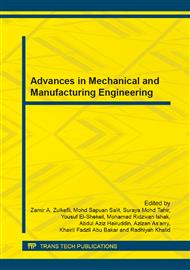[1]
M. P. Miles and G. R. Russell, Journal of Quality Management, vol. 2, no. 1, p.151–168, (1997).
Google Scholar
[2]
ISO, Management System Definition, International Organization for Standardization, 2013. [Online]. Available: http: /www. iso. org/iso/home/standards/management-standards. htm.
Google Scholar
[3]
S. Link and E. Naveh, Standardization and Discretion: Does the Environmental Standard ISO 14001 Lead to Performance Benefits?, IEEE Transactions on Engineering Management, vol. 53, no. 4, p.508–519, (2006).
DOI: 10.1109/tem.2006.883704
Google Scholar
[4]
A. Labodová, Journal of Cleaner Production, vol. 12, no. 6, p.571–580, Aug. (2004).
Google Scholar
[5]
S. Karapetrovic and J. Jonker, Total Quality Management and Business Excellence, vol. 14, no. 4, p.451–459, (2003).
DOI: 10.1080/1478336032000047264
Google Scholar
[6]
S. Karapetrovic and W. Willborn, The TQM Magazine, vol. 10, no. 3, p.204–213, (1998).
Google Scholar
[7]
G. Wilkinson and B. G. Dale, Production Planning & Control, vol. 13, no. 3, p.284–297, (2002).
Google Scholar
[8]
L. C. Angell and R. D. Klassen, Journal of Operations Management, vol. 17, no. 5, p.575–598, Aug. (1999).
Google Scholar
[9]
M. Asif, E. J. de Bruijn, O. A. Fisscher, C. Searcy, and H. -J. Steenhuis, International Journal of Quality & Reliability Management, vol. 26, no. 3, p.261–282, (2009).
DOI: 10.1108/02656710910936735
Google Scholar
[10]
M. Asif, E. J. de Bruijn, O. A. M. Fisscher, and C. Searcy, The TQM Journal, vol. 22, no. 6, p.570–582, (2010).
DOI: 10.1108/17542731011085285
Google Scholar
[11]
M. Asif, C. Searcy, A. Zutshi, and N. Ahmad, European Business Review, vol. 23, no. 4, p.353–367, (2011).
Google Scholar
[12]
M. Benhima, J. Reilly, and H. Benhima, IJCSI, Vol9, no. 5, (2012).
Google Scholar
[13]
M. Bernardo, M. Casadesus, S. Karapetrovic, and I. Heras, Journal of Cleaner Production, vol. 17, no. 8, p.742–750, (2009).
DOI: 10.1016/j.jclepro.2008.11.003
Google Scholar
[14]
M. Bernardo, M. Casadesus, S. Karapetrovic, and I. Heras, Journal of Cleaner Production, (2011).
Google Scholar
[15]
M. Bernardo, M. Casadesus, S. Karapetrovic, and I. Heras, International Journal of Operations & Production Management, vol. 32, no. 3, p.291–307, (2012).
DOI: 10.1108/01443571211212583
Google Scholar
[16]
A. Douglas and D. Glen, Total Quality Management, vol. 11, no. 4–6, p.686–690, (2000).
Google Scholar
[17]
J. Jonker and S. Karapetrovic, Business Process Management Journal, vol. 10, no. 6, p.608–615, (2004).
Google Scholar
[18]
T. H. Jørgensen, A. Remmen, and M. D. Mellado, Journal of Cleaner Production, vol. 14, no. 8, p.713–722, Jan. (2006).
Google Scholar
[19]
S. Karapetrovic, The TQM Magazine, vol. 14, no. 1, p.61–67, (2002).
Google Scholar
[20]
S. Karapetrovic, Measuring Business Excellence, vol. 7, no. 1, p.4–13, (2003).
Google Scholar
[21]
O. J. de Oliveira, Journal of Cleaner Production, (2013).
Google Scholar
[22]
G. Wilkinson and B. Dale, The TQM Magazine, vol. 11, no. 2, p.95–104, (1999).
Google Scholar
[23]
E. L. Psomas and C. V. Fotopoulos, International Journal of Quality and Service Sciences, vol. 1, no. 2, p.128–144, (2009).
Google Scholar
[24]
C. A. Cianfrani, J. J. Tsiakals, and J. West, ISO 9001: 2008 Explained. Asq Press, (2009).
Google Scholar
[25]
S. Alhawari, L. Karadsheh, A. Nehari Talet, and E. Mansour, International Journal of Information Management, vol. 32, no. 1, p.50–65, Feb. (2012).
DOI: 10.1016/j.ijinfomgt.2011.07.002
Google Scholar
[26]
A. Del Cano and M. P. de la Cruz, Journal of Construction Engineering and Management, vol. 128, no. 6, p.473–485, (2002).
Google Scholar
[27]
R. Bruckner, B. List, and J. Schiefer, Developing requirements for data warehouse systems with use cases, in Proc. 7th Americas Conf. on Information Systems, 2001, p.329–335.
Google Scholar
[28]
M. Popescu and A. Dascalu, Dynamics, vol. 2, p.23, (2011).
Google Scholar


